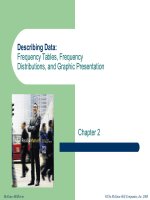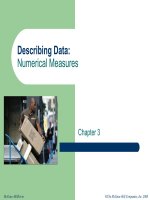Business lecture CHAPTER 10a
Bạn đang xem bản rút gọn của tài liệu. Xem và tải ngay bản đầy đủ của tài liệu tại đây (111.45 KB, 41 trang )
Chapter 10
The International
Monetary System
10-1
Introduction
Question: What is the international monetary system?
Answer:
The international monetary system refers to the institutional
arrangements that govern exchange rates
recall that the foreign exchange market is the primary institution
for determining exchange rates
10-2
Introduction
A floating exchange rate system exists in countries where the
foreign exchange market determines the relative value of a currency
Examples - the U.S. dollar, the European Union’s euro, the
Japanese yen, and the British pound
A pegged exchange rate system exists when the value of a currency
is fixed to a reference country and then the exchange rate between
that currency and other currencies is determined by the reference
currency exchange rate
Many developing countries have pegged exchange rates
10-3
Introduction
A dirty float exists when the value of a currency is determined by
market forces, but with central bank intervention if it depreciates too
rapidly against an important reference currency
China adopted this policy in 2005
With a fixed exchange rate system countries fix their currencies
against each other at a mutually agreed upon value
prior to the introduction of the euro, some European Union
countries operated with fixed exchange rates within the context
of the European Monetary System (EMS)
10-4
Introduction
Question: What role does the international monetary system play in
determining exchange rates?
Answer:
To answer this question, we have to look at the evolution of the
international monetary system
The Gold Standard
The Bretton Woods system
The International Monetary Fund
The World Bank
10-5
The Gold Standard
Question: What is the Gold Standard?
Answer:
The origin of the gold standard dates back to ancient times when
gold coins were a medium of exchange, unit of account, and store of
value
To facilitate trade, a system was developed so that payment could
be made in paper currency that could then be converted to gold at a
fixed rate of exchange
10-6
Mechanics of the Gold Standard
The gold standard refers to the practice of pegging currencies to
gold and guaranteeing convertibility
under the gold standard one U.S. dollar was defined as
equivalent to 23.22 grains of “fine (pure) gold”
The exchange rate between currencies was based on the gold par
value - the amount of a currency needed to purchase one ounce of
gold
10-7
Strength of the Gold Standard
The key strength of the gold standard was its powerful mechanism
for simultaneously allowing all countries to achieve balance-of-trade
equilibrium - when the income a country’s residents earn from its
exports is equal to the money its residents pay for imports
many people today believe the world should return to the gold
standard
10-8
1918 - 1939
The gold standard worked fairly well from the 1870s until the start of
World War I
After the war countries started regularly devaluing their currencies to
try to encourage exports
Confidence in the system fell, and people began to demand gold for
their currency putting pressure on countries' gold reserves, and
forcing them to suspend gold convertibility
The Gold Standard ended in 1939
10-9
The Bretton Woods System
A new international monetary system was designed in 1944 in
Bretton Woods, New Hampshire
The goal was to build an enduring economic order that would
facilitate postwar economic growth
The Bretton Woods Agreement established two multinational
institutions
1. The International Monetary Fund (IMF) to maintain order in the
international monetary system
2. The World Bank to promote general economic development
10-10
The Bretton Woods System
Under the Bretton Woods Agreement
the US dollar was the only currency to be convertible to gold,
and other currencies would set their exchange rates relative to
the dollar
devaluations were not to be used for competitive purposes
a country could not devalue its currency by more than 10%
without IMF approval
10-11
The Role of the IMF
The IMF was responsible for avoiding a repetition of the chaos
that occurred between the wars through a combination of
1. Discipline
a fixed exchange rate puts a brake on competitive
devaluations and brings stability to the world trade
environment
a fixed exchange rate regime imposes monetary discipline on
countries, thereby curtailing price inflation
10-12
The Role of the IMF
2. Flexibility
A rigid policy of fixed exchange rates would be too inflexible
So, the IMF was ready to lend foreign currencies to members to
tide them over during short periods of balance-of-payments
deficits
A country could devalue its currency by more than 10 percent with
IMF approval
10-13
The Role of the World Bank
The World Bank lends money in two ways
under the IBRD scheme, money is raised through bond sales in
the international capital market and borrowers pay what the
bank calls a market rate of interest - the bank's cost of funds
plus a margin for expenses.
under the International Development Agency scheme, loans go
only to the poorest countries
The official name of the World Bank is the International Bank for
Reconstruction and Development (IBRD)
10-14
The Collapse of the Fixed System
Question: What caused the collapse of the Bretton Woods system?
Answer:
The collapse of the Bretton Woods system can be traced to U.S.
macroeconomic policy decisions (1965 to 1968)
During this time, the U.S. financed huge increases in welfare
programs and the Vietnam War by increasing its money supply
which then caused significant inflation
Speculation that the dollar would have to be devalued relative to
most other currencies forced other countries to increase the value of
their currencies relative to the dollar
10-15
The Collapse of the Fixed System
The Bretton Woods system relied on an economically well managed
U.S.
So, when the U.S. began to print money, run high trade deficits, and
experience high inflation, the system was strained to the breaking
point
The Bretton Woods Agreement collapsed in 1973
10-16
The Floating Exchange Rate Regime
Question: What followed the collapse of the Bretton Woods
exchange rate system?
Answer:
Following the collapse of the Bretton Woods agreement, a floating
exchange rate regime was formalized in 1976 in Jamaica
The rules for the international monetary system that were agreed
upon at the meeting are still in place today
10-17
The Jamaica Agreement
At the Jamaica meeting, the IMF's Articles of Agreement were
revised to reflect the new reality of floating exchange rates
Under the Jamaican agreement
floating rates were declared acceptable
gold was abandoned as a reserve asset
total annual IMF quotas - the amount member countries
contribute to the IMF - were increased to $41 billion (today, this
number is $300 billion)
10-18
Exchange Rates Since 1973
Since 1973, exchange rates have become more volatile and less
predictable because of
the oil crisis in 1971
the loss of confidence in the dollar after U.S. inflation jumped
between 1977 and 1978
the oil crisis of 1979
the rise in the dollar between 1980 and 1985
the partial collapse of the European Monetary System in 1992
the 1997 Asian currency crisis
the decline in the dollar in the mid to late 2000s
10-19
Fixed vs. Floating Exchange Rates
Question: Which is better – a fixed exchange rate system or a
floating exchange rate system?
Answer:
Disappointment with floating rates in recent years has led to
renewed debate about the merits of a fixed exchange rate system
10-20
The Case for Floating Rates
A floating exchange rate system provides two attractive features
1.
monetary policy autonomy
2.
automatic trade balance adjustments
10-21
The Case for Floating Rates
1. Monetary Policy Autonomy
The removal of the obligation to maintain exchange rate parity
restores monetary control to a government
with a fixed system, a country's ability to expand or contract its
money supply is limited by the need to maintain exchange rate
parity
10-22
The Case for Floating Rates
2. Trade Balance Adjustments
The balance of payments adjustment mechanism works more
smoothly under a floating exchange rate regime
under the Bretton Woods system (fixed system), IMF approval
was needed to correct a permanent deficit in a country’s
balance of trade that could not be corrected by domestic
policy alone
10-23
The Case for Fixed Rates
A fixed exchange rate system is attractive because
1.
of the monetary discipline it imposes
2.
it limits speculation
3.
it limits uncertainty
4.
of the lack of connection between the trade balance and
exchange rates
10-24
The Case for Fixed Rates
1. Monetary Discipline
Because a fixed exchange rate system requires maintaining
exchange rate parity, it also ensures that governments do not
expand their money supplies at inflationary rates
2. Speculation
A fixed exchange rate regime prevents destabilizing speculation
10-25









